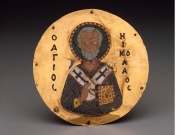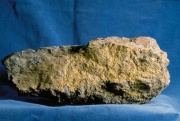Difference between revisions of "Uranium"
(username removed) |
|||
| (9 intermediate revisions by 2 users not shown) | |||
| Line 1: | Line 1: | ||
| − | [[File: | + | [[File:SC297757.jpg|thumb|Orange uranium glaze,<be>MFA# 2012.1112]] |
| + | [[File:Byzantine 28243.jpg|thumb|Byzantine plaque]] | ||
== Description == | == Description == | ||
| − | A naturally radioactive metallic element. Uranium was discovered in 1781 by Sir William Herschel and isolated by Klaproth in 1789. It has an abundance of 2.1 ppm in the earth's crust and primarily occurs in pitchblende, coffinite, and carnotite ores. Uranium ores are mined in France, Zaire, Canada, South Africa, Australia, Russia, and the U.S. (Colorado, New Mexico, Utah). Uranium is a silvery white metal that is ductile and malleable. It polishes to a high gloss but tarnishes quickly in air. Uranium undergoes a series of nuclear fission reactions to eventually produce [ | + | A naturally radioactive metallic element. Uranium was discovered in 1781 by Sir William Herschel and isolated by Klaproth in 1789. It has an abundance of 2.1 ppm in the earth's crust and primarily occurs in pitchblende, coffinite, and carnotite ores. Uranium ores are mined in France, Zaire, Canada, South Africa, Australia, Russia, and the U.S. (Colorado, New Mexico, Utah). Uranium is a silvery white metal that is ductile and malleable. It polishes to a high gloss but tarnishes quickly in air. Uranium undergoes a series of nuclear fission reactions to eventually produce [[lead]]. Because these reactions are used in nuclear weapons and nuclear powder plants, radioactive uranium has not been commercially available since 1944. Uranium salts and depleted uranium oxides are used as [[mordant|mordants]] for [[dye|dyes]], toners in photography, and [[pigment|pigments]] in [[glass]], [[paint|paints]], and [[ceramic|ceramics]]. Uranium oxides produce red and orange colors at about 940 C while slightly higher temperatures give a soft yellow color (Kawai's yellow). It can turn gray or black at temperatures above 1260 C. |
[[File:Uraniumemr1.jpg|thumb|Uranium ore]] | [[File:Uraniumemr1.jpg|thumb|Uranium ore]] | ||
| + | |||
== Synonyms and Related Terms == | == Synonyms and Related Terms == | ||
U; uranium salts; Kawai's yellow | U; uranium salts; Kawai's yellow | ||
| − | == | + | == Risks == |
| + | |||
| + | * Flammable. Burns in air at 150-175 C. Powder ignites spontaneously in air. | ||
| + | * Highly toxic. | ||
| + | * Radioactive. | ||
| + | * Contact causes burns. | ||
| + | * Suspected carcinogen. | ||
| + | * USDE: [https://www.energy.gov/sites/prod/files/2020/11/f80/SDS-Uranium_Metal_2020.pdf SDS] | ||
| + | |||
| + | ==Physical and Chemical Properties== | ||
Reactive with all metals, water, acids and peroxides. Inert to alkalis. | Reactive with all metals, water, acids and peroxides. Inert to alkalis. | ||
| Line 22: | Line 33: | ||
|- | |- | ||
! scope="row"| Melting Point | ! scope="row"| Melting Point | ||
| − | | 1132-1133 | + | | 1132-1133 C |
|- | |- | ||
! scope="row"| Density | ! scope="row"| Density | ||
| − | | 19.05 | + | | 19.05 g/ml |
|- | |- | ||
! scope="row"| Molecular Weight | ! scope="row"| Molecular Weight | ||
| Line 31: | Line 42: | ||
|- | |- | ||
! scope="row"| Boiling Point | ! scope="row"| Boiling Point | ||
| − | | 3818 | + | | 3818 C |
|} | |} | ||
| − | == | + | ==Resources and Citations== |
| − | |||
| − | |||
| − | |||
| − | |||
| − | |||
| − | |||
| − | |||
| − | |||
* G.S.Brady, ''Materials Handbook'', McGraw-Hill Book Co., New York, 1971 Comment: p. 834 | * G.S.Brady, ''Materials Handbook'', McGraw-Hill Book Co., New York, 1971 Comment: p. 834 | ||
Latest revision as of 11:41, 23 June 2022
Description
A naturally radioactive metallic element. Uranium was discovered in 1781 by Sir William Herschel and isolated by Klaproth in 1789. It has an abundance of 2.1 ppm in the earth's crust and primarily occurs in pitchblende, coffinite, and carnotite ores. Uranium ores are mined in France, Zaire, Canada, South Africa, Australia, Russia, and the U.S. (Colorado, New Mexico, Utah). Uranium is a silvery white metal that is ductile and malleable. It polishes to a high gloss but tarnishes quickly in air. Uranium undergoes a series of nuclear fission reactions to eventually produce Lead. Because these reactions are used in nuclear weapons and nuclear powder plants, radioactive uranium has not been commercially available since 1944. Uranium salts and depleted uranium oxides are used as mordants for dyes, toners in photography, and pigments in Glass, paints, and ceramics. Uranium oxides produce red and orange colors at about 940 C while slightly higher temperatures give a soft yellow color (Kawai's yellow). It can turn gray or black at temperatures above 1260 C.
Synonyms and Related Terms
U; uranium salts; Kawai's yellow
Risks
- Flammable. Burns in air at 150-175 C. Powder ignites spontaneously in air.
- Highly toxic.
- Radioactive.
- Contact causes burns.
- Suspected carcinogen.
- USDE: SDS
Physical and Chemical Properties
Reactive with all metals, water, acids and peroxides. Inert to alkalis.
| Composition | U (atomic no. 92) |
|---|---|
| CAS | 7440-61-1 |
| Melting Point | 1132-1133 C |
| Density | 19.05 g/ml |
| Molecular Weight | atomic wt = 238.029 |
| Boiling Point | 3818 C |
Resources and Citations
- G.S.Brady, Materials Handbook, McGraw-Hill Book Co., New York, 1971 Comment: p. 834
- Richard S. Lewis, Hawley's Condensed Chemical Dictionary, Van Nostrand Reinhold, New York, 10th ed., 1993
- Robert Fournier, Illustrated Dictionary of Practical Pottery, Chilton Book Company, Radnor, PA, 1992
- Van Nostrand's Scientific Encyclopedia, Douglas M. Considine (ed.), Van Nostrand Reinhold, New York, 1976
- Random House, Webster's Encyclopedic Unabridged Dictionary of the English Language, Grammercy Book, New York, 1997
- The Merck Index, Martha Windholz (ed.), Merck Research Labs, Rahway NJ, 10th edition, 1983 Comment: entry 9990
- The American Heritage Dictionary or Encarta, via Microsoft Bookshelf 98, Microsoft Corp., 1998


